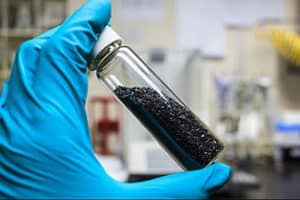Overview Of Activated Carbon
November 29th, 2023 | Posted in Air Cleaners
What Is Activated Carbon?

How Does Activated Carbon Actually Work To Remove Contaminants?
Activated Carbon does not “soak it up like a sponge.” That “soaking up” process is called absorption (note that the word is spelled with a “b”). In absorption, the liquid fills the pore spaces in the sorbent material and is not limited to the surface area of the sorbent bed.
By contrast, activated carbon works by adsorption (spelled with a “d”). In adsorption the contaminants cling to walls of the micropores and do not fill up the pores brimful as is the case with absorption. Adsorption works by weak electromagnetic interaction between transient dipoles. We need to define some terms to make sense of the previous sentence. A “dipole” is, in our case, a molecule that has a positive and a negative pole. That raises a question: “How can a hydrocarbon contaminant, which is usually defined as being “non-polar” be a dipole?
The answer to that question lies in the use of the word “transient.” Something that is transient passes especially quickly into and out of existence. Since electrons are constantly hovering from one side to another of an atom (and therefore a molecule) those movements are creating tiny very temporary (“transient”) positive and negative charge poles (“dipoles”) in the molecules to be collected. Similar transient dipoles are also created in the walls of the activated carbon micropores. When the transient poles of the contaminants molecule and adjacent carbon atoms in the micropores “line up,” the contaminant molecule sticks to the activated carbon and is removed from the air stream. These transient electromagnetic forces are called “Van Der Walls Forces.”
What Is Activated Carbon Used For?
For the removal of gas-phase contaminants (in gas-phase applications) activated carbon is commonly used in the form of hard granules, or hard, relatively dust-free pellets in an adsorbent bed. Activated carbon may also be incorporated in the filter material of media air filtration systems. Characteristics of activated carbon that make it desirable for air purification include:
- a high adsorptive capacity per unit volume,
- a high retention capacity,
- a high preferential adsorption of gases in the presence of moisture,
- a low resistance to gas flow, and
- a complete release of adsorbates at increasing temperatures and decreasing pressures. This last property makes it possible to “regenerate” or purge the activated carbon of adsorbed contaminants for reuse. [i]
In addition to the thermal and chemical treatments noted above, activated carbon can also be impregnated with reactants to increase the scope of contaminants that it can remove. Uses of impregnated activated carbon include:
- Removal of light gases are the control of toxic or odorous gases in sewage treatment plants, pulp mills, and other sources.
- Removal of hydrogen sulfide and mercaptans can be achieved by fixing them as insoluble sulfides by impregnating the activated carbon with copper sulfate or lead acetate,
- Neutralizing sulfur-containing compounds by impregnating the carbon with a strong base such as sodium hydroxide or potassium
- Alkali-impregnated activated carbon is also effective against sulfur dioxide and chlorine at low concentrations. An alternative is impregnation with potassium iodide which acts as a catalyst for the formation of elemental sulfur, reducing the amount of sulfuric acid produced.
- Ammonia and amines can be removed by activated carbon impregnated with phosphoric acid or zinc acetatei.
Pros And Cons Of Using Activated Carbon
The advantages of activated carbon include:
- High efficiency in VOC removal. Activated carbon can contain up to 25% of its weight in light hydrocarbons.
- Simple and robust technology – just a bed of activated carbon in a porous container that allows the air to be filtered to pass through.
- Suitable for discontinuous processes.
- Easy to maintain – just replace the activated carbon when necessary.
- Easy to place.
Disadvantages include:
- Excessive dust loading can lead to blockages.
- Component mixes may lead to early malfunction.
- Risk of spontaneous combustion in the bed (ketones, turpentines…).
- Polymerisation risk for unsaturated hydrocarbons on the activated carbon (exothermal and causes blockages).
Ask your Air Quality Engineering representative if activated carbon is appropriate for your application.
[i] Activated Carbon and Adsorption
F. Rodríguez-Reinoso, in Encyclopedia of Materials: Science and Technology, 2001